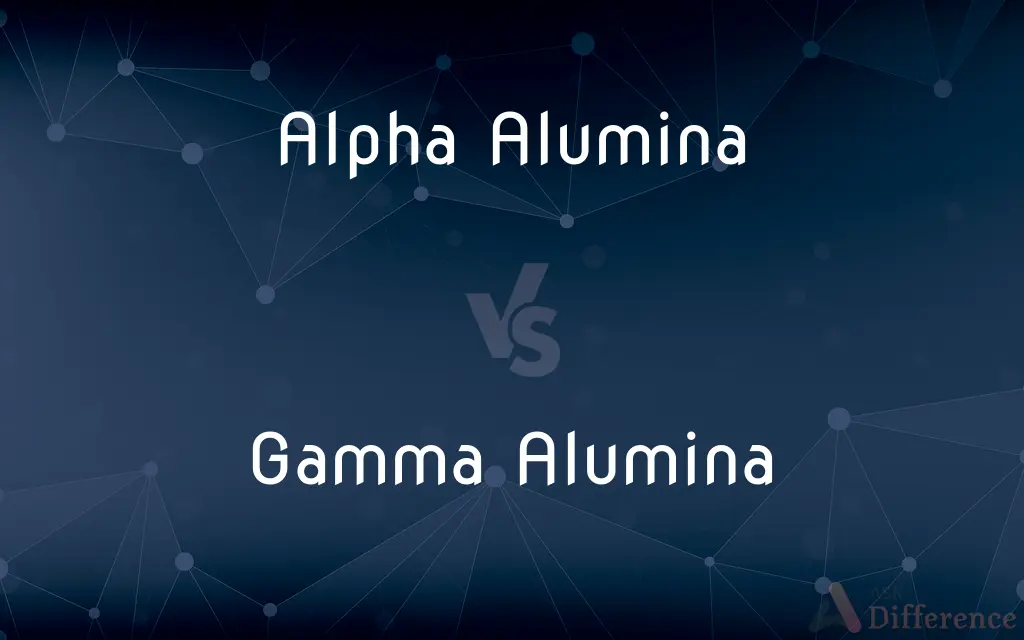Alpha Alumina vs. Gamma Alumina — What's the Difference?
Edited by Tayyaba Rehman — By Fiza Rafique — Published on December 9, 2023
Alpha Alumina is a stable, hexagonal crystal structure. Gamma Alumina is a metastable, cubic crystal form of aluminum oxide.

Difference Between Alpha Alumina and Gamma Alumina
Table of Contents
ADVERTISEMENT
Key Differences
Alpha Alumin and Gamma Alumina are two different phases of aluminum oxide. Alpha Alumin is the most stable form of aluminum oxide, characterized by a hexagonal crystal structure.
Gamma Alumina, in contrast, is a metastable form of aluminum oxide. It possesses a cubic or spinel-like structure and can be transformed into the stable alpha phase at higher temperatures.
When discussing the commercial and industrial applications of these materials, Alpha Alumin's stable nature makes it ideal for structural and abrasive purposes. This stability means that it doesn't readily undergo phase transformations under typical conditions.
Conversely, Gamma Alumina's more porous and active nature often finds its use in catalysis and adsorption processes. The metastable structure of Gamma Alumina allows for more surface reactivity, which can be beneficial in certain applications.
Lastly, it's important to recognize that while both these phases are derivatives of aluminum oxide, their distinct structural differences lead to varied properties and applications. Alpha Alumin's hardness and stability contrast with the versatility and reactivity of Gamma Alumina.
ADVERTISEMENT
Comparison Chart
Crystal Structure
Hexagonal
Cubic or spinel-like
Stability
Most stable form of aluminum oxide
Metastable form of aluminum oxide
Typical Applications
Structural and abrasive purposes
Catalysis and adsorption
Reactivity
Less reactive due to stable structure
More reactive due to metastable nature
Transformation at High Temp.
Remains in the alpha phase
Can transform into the alpha phase
Compare with Definitions
Alpha Alumina
Exhibits a hexagonal crystal structure.
The hexagonal structure of Alpha Alumin contributes to its stability.
Gamma Alumina
Can transition to the alpha phase at high temperatures.
Heating Gamma Alumina can induce a phase transformation to Alpha Alumin.
Alpha Alumina
Resistant to phase transformations.
Even under high temperatures, Alpha Alumin retains its phase.
Gamma Alumina
Features a cubic or spinel-like structure.
The distinct structure of Gamma Alumina makes it unique.
Alpha Alumina
Less reactive compared to other aluminum oxide phases.
Alpha Alumin's stability reduces its reactivity in many processes.
Gamma Alumina
Often employed in catalysis due to its reactivity.
The reactivity of Gamma Alumina makes it suitable for catalytic converters.
Alpha Alumina
The most stable form of aluminum oxide.
Alpha Alumin is preferred for its durability and hardness.
Gamma Alumina
A metastable phase of aluminum oxide.
Gamma Alumina can transform into other phases under certain conditions.
Alpha Alumina
Used predominantly for abrasive applications.
Due to its hardness, Alpha Alumin is used in grinding wheels.
Gamma Alumina
Has a porous nature beneficial for adsorption.
Gamma Alumina is used in filters because of its porous characteristics.
Common Curiosities
Which form of aluminum oxide is the most stable?
Alpha Alumin is the most stable form.
What is the crystal structure of Gamma Alumina?
Gamma Alumina has a cubic or spinel-like structure.
In what applications is Alpha Alumin commonly used?
Alpha Alumin is commonly used for structural and abrasive purposes.
Is Alpha Alumin used in catalytic processes?
While possible, it's less common as Gamma Alumina is more favored for its reactivity in catalytic processes.
Can Alpha Alumin transition to Gamma Alumina?
Typically, it's Gamma Alumina that can transition to Alpha Alumin under certain conditions, not the other way around.
Why is Gamma Alumina used in catalysis?
Gamma Alumina's metastable nature and porosity make it reactive, suitable for catalysis.
What crystal structure does Alpha Alumin exhibit?
Alpha Alumin has a hexagonal crystal structure.
Are Alpha Alumin and Gamma Alumina both forms of aluminum oxide?
Yes, both are different phases of aluminum oxide.
Are there other forms of aluminum oxide besides Alpha Alumin and Gamma Alumina?
Yes, aluminum oxide has multiple phases, but Alpha and Gamma are two prominent ones.
Does Gamma Alumina transform at high temperatures?
Yes, Gamma Alumina can transform into the alpha phase at higher temperatures.
Which form of aluminum oxide is more reactive?
Gamma Alumina is generally more reactive due to its metastable nature.
Which phase of aluminum oxide is harder?
Alpha Alumin is typically harder due to its hexagonal and stable structure.
How does the stability of Alpha Alumin affect its applications?
Its stability makes it resistant to phase transformations, making it ideal for durable applications like abrasives.
Is Gamma Alumina's structure beneficial for any specific applications?
Yes, its structure offers porosity, which is beneficial for adsorption processes.
Can the terms Alpha Alumin and Gamma Alumina be used interchangeably?
No, they refer to different phases of aluminum oxide with distinct properties.
Share Your Discovery

Previous Comparison
Somatic Nervous System vs. Autonomic Nervous System
Next Comparison
Grana vs. ThylakoidAuthor Spotlight
Written by
Fiza RafiqueFiza Rafique is a skilled content writer at AskDifference.com, where she meticulously refines and enhances written pieces. Drawing from her vast editorial expertise, Fiza ensures clarity, accuracy, and precision in every article. Passionate about language, she continually seeks to elevate the quality of content for readers worldwide.
Edited by
Tayyaba RehmanTayyaba Rehman is a distinguished writer, currently serving as a primary contributor to askdifference.com. As a researcher in semantics and etymology, Tayyaba's passion for the complexity of languages and their distinctions has found a perfect home on the platform. Tayyaba delves into the intricacies of language, distinguishing between commonly confused words and phrases, thereby providing clarity for readers worldwide.
















































